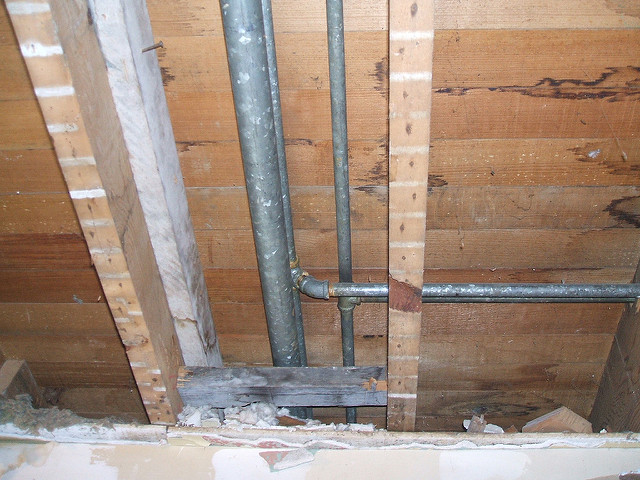How to Check If Your Home Has a Covert Leak
How to Check If Your Home Has a Covert Leak
Blog Article
Each person seems to have their own individual conception on the subject of Leaking water lines.

Early detection of dripping water lines can mitigate a prospective catastrophe. Besides saving you money, it will certainly minimize the worry and also irritation. The minute you find a leakage, calling your plumber for repairs is the most effective service. However, some tiny water leakages may not be visible. If you can not spot it with your naked eyes, right here are some hacks that assist.
1. Examine the Water Meter
Examining it is a guaranteed method that aids you discover leakages. If it relocates, that suggests a fast-moving leakage. This suggests you might have a slow-moving leak that might even be underground.
2. Check Water Consumption
Analyze your water expenses as well as track your water intake. As the one paying it, you need to observe if there are any type of discrepancies. If you find sudden changes, despite your usage being the same, it means that you have leaks in your plumbing system. Remember, your water bill ought to fall under the same array on a monthly basis. An unexpected spike in your expense indicates a fast-moving leakage.
A steady increase every month, even with the exact same practices, shows you have a slow leak that's additionally gradually escalating. Call a plumber to extensively check your residential or commercial property, specifically if you really feel a cozy area on your flooring with piping underneath.
3. Do a Food Coloring Test
When it comes to water consumption, 30% comes from bathrooms. Examination to see if they are running effectively. Decline flecks of food color in the tank as well as wait 10 minutes. There's a leak in between the storage tank and bowl if the color somehow infiltrates your bowl during that time without flushing.
4. Asses Exterior Lines
Do not neglect to examine your exterior water lines also. Examination spigots by attaching a yard hose pipe. Must water leak out of the link, you have a loosened rubber gasket. Change this as well as make sure all links are tight. If you have actually got a lawn sprinkler, it will help get it skillfully took a look at and kept annually. One tiny leakage can throw away lots of water and also increase your water costs.
5. Examine the circumstance and inspect
House owners ought to make it a habit to check under the sink counters as well as also inside cabinets for any kind of bad odor or mold development. These 2 warnings suggest a leakage so timely attention is needed. Doing routine examinations, also bi-annually, can save you from a major trouble.
Examine for stainings as well as deteriorating as a lot of home appliances as well as pipelines have a life span. If you think leaking water lines in your plumbing system, do not wait for it to escalate.
Early detection of leaking water lines can minimize a prospective calamity. Some tiny water leakages may not be visible. Examining it is a proven means that assists you find leaks. One little leak can throw away tons of water as well as increase your water expense.
If you presume dripping water lines in your plumbing system, don't wait for it to escalate.
WARNING SIGNS OF WATER LEAKAGE BEHIND THE WALL
PERSISTENT MUSTY ODORS
As water slowly drips from a leaky pipe inside the wall, flooring and sheetrock stay damp and develop an odor similar to wet cardboard. It generates a musty smell that can help you find hidden leaks.
MOLD IN UNUSUAL AREAS
Mold usually grows in wet areas like kitchens, baths and laundry rooms. If you spot the stuff on walls or baseboards in other rooms of the house, it’s a good indicator of undetected water leaks.
STAINS THAT GROW
When mold thrives around a leaky pipe, it sometimes takes hold on the inside surface of the affected wall. A growing stain on otherwise clean sheetrock is often your sign of a hidden plumbing problem.
PEELING OR BUBBLING WALLPAPER / PAINT
This clue is easy to miss in rooms that don’t get much use. When you see wallpaper separating along seams or paint bubbling or flaking off the wall, blame sheetrock that stays wet because of an undetected leak.
BUCKLED CEILINGS AND STAINED FLOORS
If ceilings or floors in bathrooms, kitchens or laundry areas develop structural problems, don’t rule out constant damp inside the walls. Wet sheetrock can affect adjacent framing, flooring and ceilings.
https://www.servicemasterbyzaba.com/blog/how-to-detect-water-leakage-in-walls/

We had been made aware of that article on Hacks to detect leaks through someone on our other web blog. Do you know about another individual who is serious about the subject? Be sure share it. We value reading our article about Finding hidden leaks.
Report this page